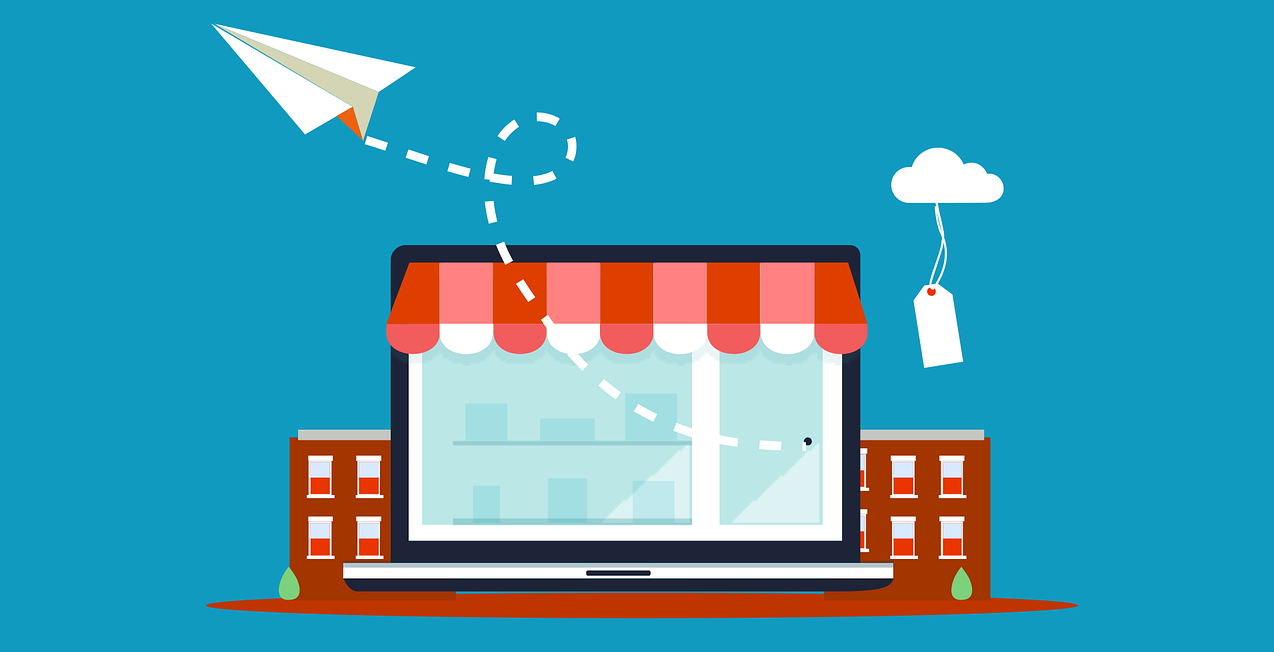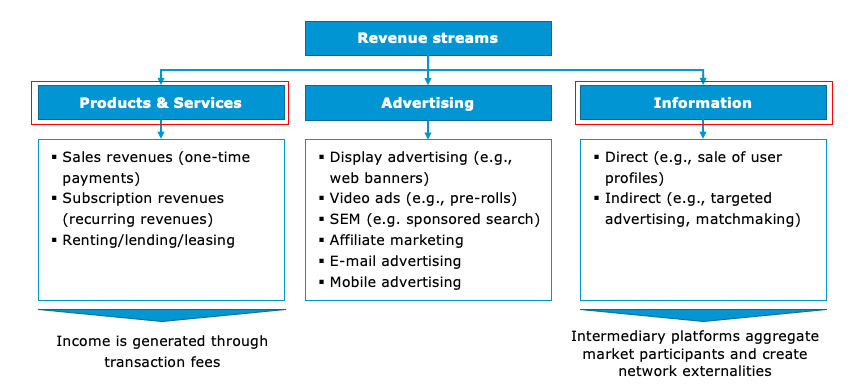The Electronic Market Place #
eBusiness, or electronic business, refers to the conduct of business activities through electronic means, such as the internet. It includes a wide range of activities, including buying and selling goods and services online, electronic payments and money transfers, electronic communication and data exchange, and the use of electronic systems to manage and coordinate business operations. Some examples of eBusiness include online retail stores, online marketplaces, and business-to-business (B2B) eCommerce platforms.

eBusiness has become increasingly popular in recent years due to the convenience and accessibility it provides to both businesses and consumers. It has also allowed for the expansion of businesses beyond traditional brick-and-mortar locations, making it easier for companies to reach a global market. However, it also presents challenges, such as the need for secure and reliable systems to protect sensitive information and the need to adapt to constantly evolving technologies.
Business models #
If You’re Not Paying for It, You’re the Product
A business model is a plan or framework that a company uses to generate revenue and make a profit. It outlines the way that a business intends to operate and make money, and can include the products or services it offers, the target market it serves, the channels through which it reaches customers, and the resources and partnerships it uses to create and deliver value.
An online business model involves conducting business through the internet, while an offline business model involves face-to-face or physical interactions.
Online business models typically involve setting up a website or an e-commerce platform, where customers can browse and purchase products or services. Payment is often made through electronic means, such as credit cards or online payment systems. Some examples of online business models include subscription-based services, such as streaming platforms or software as a service (SaaS), as well as e-commerce stores that sell physical or digital products.
Offline business models, on the other hand, involve in-person interactions and transactions. This can include brick-and-mortar stores, restaurants, and service-based businesses, such as salons or automotive repair shops. Customers typically visit the physical location to purchase products or services and may pay with cash, credit cards, or other forms of payment.
Both online and offline business models have their own advantages and disadvantages. Online business models can reach a wider audience and may have lower overhead costs, but may also face competition from other online businesses. Offline business models may have higher overhead costs, but may also have the advantage of personal interactions with customers and a more established presence in the local community.
There are many different business models that companies can use, and the choice of a particular model will depend on a variety of factors, including the nature of the business, the needs of its customers, and the competitive environment in which it operates. Some common business models include:
- Retail business model: A company that sells products directly to consumers through a physical storefront or online store.
- Wholesale business model: A company that sells products to other businesses, rather than directly to consumers.
- Manufacturing business model: A company that produces goods for sale, either to other businesses or to consumers.
- Service business model: A company that provides services, such as consulting, marketing, or repair, to other businesses or consumers.
- Subscription business model: A company that charges customers a regular fee for access to a product or service, such as a magazine or streaming service.
- Freemium business model: A company that offers a basic product or service for free, but charges for additional features or premium access.
- Sharing economy business model: A company that facilitates the sharing of resources or services between individuals, such as ride-sharing or home-sharing platforms.

In-class task
Read the article Entrepreneur alert: If Uber’s more disruptive, why is Airbnb making all the money? by Allen Adamson and Eitan Muller.
Switching Business Models #
Switching business models can be a significant decision for a business and requires careful planning and consideration. It’s important to evaluate the potential benefits and risks of switching business models and to have a clear strategy in place before making any changes.
There are several reasons why a business might consider switching business models. For example, a business may want to switch to a new model to better meet the needs of its customers, to take advantage of new market opportunities, or to improve its profitability.
Before switching business models, it’s important to thoroughly research the new model and understand how it will affect the business. This may involve analyzing market trends, customer needs, and the competitive landscape. It’s also important to consider the resources and infrastructure needed to support the new model and to develop a plan to implement the switch. Switching business models can be a risky proposition, and it’s important to be prepared for the possibility that the change may not be successful. However, if done carefully and with a clear strategy in place, switching business models can help a business adapt to changing market conditions and continue to grow and succeed.
Example: Downloads to Music Streaming
In recent years, there has been a significant shift in the music industry from download to streaming as the primary means of consuming music. This shift has been driven by the increasing availability and popularity of streaming services such as Spotify, Apple Music, and Pandora, which offer users the ability to listen to vast libraries of music for a monthly subscription fee or on a free, ad-supported basis. As a result of this shift, music downloads have declined, and the music industry has had to adapt to the new economic model of streaming. This transition has not been without controversy, as some artists and industry insiders have expressed concerns about the sustainability of the streaming model and its impact on artists’ revenues. Despite these concerns, streaming shows no signs of slowing down and is likely to remain the dominant way that people listen to music in the coming years.
Economies of scale: The bigger, the stronger #
The larger digital markets become, the more they can benefit from economies of scale. In addition to cost advantages, there are also network effects that have a predominantly positive impact in the electronic market.
Network effects and two-sided markets are related concepts in that both refer to the ways in which the value of a product or service is influenced by the number of people using it.
Network effects, or demand-side economies of scale, refer to the phenomenon in which a product or service becomes more valuable as more people use it. There are two types of network effects: positive and negative.
Positive network effects, also known as demand-side network effects, occur when a product becomes more valuable to a user as more people use it. For example, the value of a social networking site increases as more people join and connect with each other, because the user has a larger pool of potential friends and connections. This can create a virtuous cycle in which a product becomes more popular as it becomes more valuable, leading to even more users and further increases in value.
Negative network effects, also known as supply-side network effects, occur when a product becomes less valuable as more people use it. For example, the value of a limited resource, such as a natural habitat, may decrease as more people use it, because the resource becomes more scarce and less available for each individual.
Network effects can have significant impacts on the success of a product or service, and can create barriers to entry for new competitors. Companies that are able to establish a strong network of users early on may be able to capture a large share of the market and create a competitive advantage. However, it is also possible for a product with negative network effects to reach a tipping point, at which point the value of the product decreases significantly and adoption slows or stops.
Multi-sided markets, also known as multi-sided platforms, are businesses that facilitate interactions between multi distinct groups of users, each of which derives value from the platform. These platforms create value by connecting the different sides and enabling them to transact with each other. Examples of multi-sided markets include credit card networks, online marketplaces, and social media platforms.
Multi-sided markets often face challenges in terms of pricing and attracting users to both sides of the platform. For example, a credit card network needs to attract both merchants and consumers to the platform in order to generate revenue, but these distinct groups may have different incentives and preferences. To address this challenge, multi-sided markets may use a variety of pricing strategies, such as offering incentives to one side of the platform to encourage adoption, or charging different prices to different sides.
Multi-sided markets can be an effective way to create value by connecting different groups of users and facilitating transactions between them. However, they can also face regulatory challenges, as they may be subject to scrutiny for their potential to wield market power and influence the behavior of users on both sides of the platform.
In both cases, the value of the product or service is influenced by the number of people using it, but the direction of the effect (positive or negative) and the specific nature of the product or service differ. Network effects can apply to a wide range of products, while multi-sided markets are specific to businesses that facilitate interactions between multi groups of users.
Online Reviews & Ratings #
Explicit feedback from past or existing customers can help both the company and future customers in decision making. There are many ways to ask for feedback. Two common options are (1) textual reviews and (2) more structured ratings and both are known to affect sales 1.
There are many ways to let people rate products, or services. On the one hand, there are different rating scales (binary, ordinal or metric) and on the other hand, ratings can be collected at brand, product or property level. The choice of which system to use is a tradeoff between the number of feedbacks, the fineness of feedbacks, and the presence of biases.

The simpler the scale, the more feedback there usually is. Thus, from the customer’s point of view, it is often easier to say whether product is good or bad instead of evaluating it on a grading scale. That was also one of the main reasons why Netflix switched in 2017 from a 5-star rating to a thumbs up/thumbs down2.
But at the same time you lose valuable information, because there could be differences between “good” and “very good” products. Especially, if you want to describe or predict customer preferences (e.g., recommender systems) strong explicit feedback signals are essential. Consequently, Netflix recently switched to a rating scale with three options (i.e., not for me, I like it, Love this!)3.
In some cases, you want to evaluate not only the product as a whole, but certain properties in more detail. Especially for larger purchases such as travel or products with many facets, multidimensional rating systems can be important. Empirical evidence suggest that the multidimensional rating system helps consumers find products that better fit their preferences and increases the confidence of their choices4.
Challenges #
The electronic marketplace offers not only advantages, but also disadvantages. In this section, we will look at a subset of problems in more detail.
Personal touch #
Online markets can lack the personal touch that is often present in traditional brick and mortar stores. The majority of products are still sold offline, and the “touch-and-feel” aspect of physically examining a product before purchase remains important to many consumers. In a physical store, customers can interact with sales staff, try on clothes, and ask questions about products. This level of personal interaction is not always possible in an online market. Notably, significant discrepancies can exist between how consumers evaluate products when examining them offline versus based on online descriptions, even for a relatively familiar product5.
However, there are ways that businesses can create a sense of personalization in their online market. For example, they can use personalized emails, recommendations based on a customer’s past purchases, and personalized landing pages. In addition, businesses can use live chat or video chat tools to connect with customers in real-time and offer personalized support. By using these tools, businesses can provide a level of personal interaction that is similar to what customers would experience in a physical store.
Not being able to view or try on physical products can lead to a significantly higher return rate in online channles. Promotions such as liberal return policies, free shipping promotions or sales are likely to exacerbate this problem6. From a customer’s perspective, the amount and “helpfulness” of online product reviews can help the reduce the uncertainty in product quality7.
Overall, it’s important for businesses to find ways to create a personal connection with their customers in the digital market, as this can help build trust and loyalty and ultimately drive sales.
Delivery time #
Delivery time is an important factor to consider in electronic markets, as it can affect a customer’s decision to make a purchase. Customers expect to receive their orders in a timely manner, and if they don’t, they may become frustrated and less likely to make future purchases. Faster delivery times may lead to an increase in online and offline sales8. There are several factors that can affect delivery time in electronic markets, including the distance between the seller and the customer, the type of shipping method used, and the availability of the item.
To improve delivery times, businesses can use faster shipping methods such as express or overnight delivery. They can also invest in efficient order fulfillment systems and work with reliable shipping partners. Another option is to offer local pickup or delivery options for customers who live in close proximity to the business. This can help reduce delivery times and provide a more convenient option for customers.
Overall, it’s important for businesses to be transparent about delivery times and to do their best to meet the expectations of their customers. This can help build trust and loyalty and improve the customer experience.
References & Further Reading #
- Haviv, Avery, Yufeng Huang, and Nan Li. “Intertemporal demand spillover effects on video game platforms.” Management Science 66.10 (2020): 4788-4807.
- Gauri, D. K. et al. (2021). Evolution of retail formats: Past, present, and future. Journal of Retailing, 97(1), 42-61.
Reimers, I., & Waldfogel, J. (2021). Digitization and pre-purchase information: the causal and welfare impacts of reviews and crowd ratings. American Economic Review, 111(6), 1944-71. ↩︎
https://variety.com/2017/digital/news/netflix-kills-star-ratings-thumbs-up-thumbs-down-1202023257/ ↩︎
https://variety.com/2022/digital/news/netflix-two-thumbs-up-ratings-1235228641/ ↩︎
Chen, P. Y., Hong, Y., & Liu, Y. (2018). The value of multidimensional rating systems: Evidence from a natural experiment and randomized experiments. Management Science, 64(10), 4629-4647. ↩︎
Dzyabura, D., Jagabathula, S., & Muller, E. (2019). Accounting for discrepancies between online and offline product evaluations. Marketing Science, 38(1), 88-106. ↩︎
Shehu, E., Papies, D., & Neslin, S. A. (2020). Free shipping promotions and product returns. Journal of Marketing Research, 57(4), 640-658. ↩︎
Sahoo, N., Dellarocas, C., & Srinivasan, S. (2018). The impact of online product reviews on product returns. Information Systems Research, 29(3), 723-738. ↩︎
Fisher, M. L., Gallino, S., & Xu, J. J. (2019). The value of rapid delivery in omnichannel retailing. Journal of Marketing Research, 56(5), 732-748. ↩︎